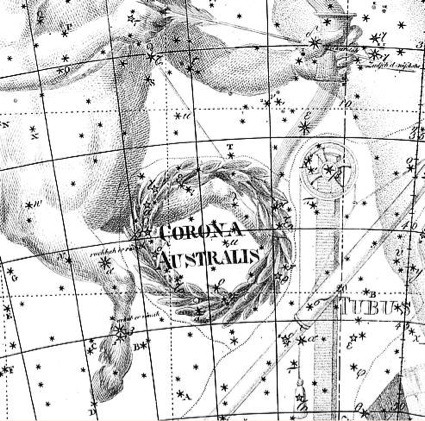
Out of the 48 constellations charted by Ptolemy, Corona Australis is one of the original ones endured to become a part of the 88 modern constellations recognized by the International Astronomical Union. It is the counterpart to Corona Borealis and is also called the ‘Southern Crown’. From the Hercules family of constellations, it is a small, faint constellation with no bright stars. Aratus referred to it as a circlet of stars beneath the forefeet of Sagittarius. It has perhaps, slipped off the archer’s head. It can be best visible in the month of August at 9 pm. Let us discuss this in detail.
This constellation does not have any stars brighter than the 4th magnitude. Some notable stars are:
- Alphekka Meridiana or α Coronae Australis (Alpha Coronae Australis): It is the only named star which got its traditional name Alphekka after Alphecca, the brightest star in the northern Corona Borealis constellation. It is a class A2V star having an apparent magnitude of about 4.10. It lies approximately 130 light years distant.
- β Coronae Australis (Beta Coronae Australis): It is a K–type bright giant with an absolute magnitude of –1.8. Its apparent magnitude is about 4.117 and it lies 510 light years distant.
- R Coronae Australis: It is a variable star. The star is relatively young as it has still been accumulating material onto its surface. It has a magnitude of about 11.5 and it lies approximately 26.8 light years away from the earth.
- RX J1856.5-3754: This is a neutron star formed by a supernova explosion of its companion star around a million years ago.
This constellation contains interesting clusters and a region of nebulosity. They are:
- Corona Australis Nebula: This was formed when numerous stars were stuck in a dark cloud of dust. It is also a star forming nebula with a number of young stars set within it.
- NGC 6541: It is a huge, bright globular cluster.
- NGC 6726/NGC 6727: It is a reflection nebula light up by the stars TY Coronae Australis and HD 176386.
- NGC 6729 (Caldwell 68): This is a fan–shaped emission nebula.
- Coronet cluster: it is a small open star cluster. It lies at the heart of the constellation and is about 420 light years distant from the earth.
Seen at latitudes between +40° and -90°, it lies in the third quadrant of the southern hemisphere.
It occupies an area of 128 square degrees, making it the 80th constellation in the sky. The furthest star in this constellation is 510 light years away from the earth and the closest star is about 58 light years distant from the earth. Therefore, it can be said that Corona Australis is 510 light years distant from the earth.
Corona Australis was known as a wreath by the Greeks and not a crown. Some myths associate it with the myth of Dionysus; according to the story, the crown was placed in the sky by the god after his mother Sernele was freed from Hades, the god of the underworld. The same myth is also associated with the Corona Borealis constellation, the Northern Crown.

Corona Australis is surrounded by constellations like Ara, Sagittarius, Scorpius and Telescopium.


